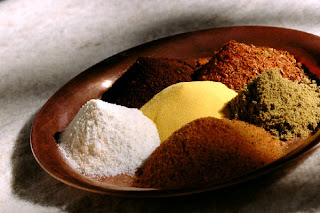Herbs have long been used by humans for culinary, medicinal, and cosmetic purposes. Herbs often are used in cooking to enhance the flavor of foods without the addition of extra fat, sugar, or sodium. Culinary herbs are known for taking ordinary foods and turning them into mouthwatering delicacies. They are sold as fresh, dried and as live plants. Some of the more popular are basil, cilantro, chives, dill, mint, oregano, parsley, rosemary, sage, and thyme.
When using herbs in cooking, let your taste buds guide you. Since dried herbs are stronger than fresh herbs you will need to use more of the fresh herbs. If the recipe calls for 1 teaspoon of dried or crushed herbs or ¼ teaspoon of powdered herbs, use 3 teaspoons (1 tablespoon) of fresh.
Powerful phytochemical compounds found in these plants may even help in the prevention of serious diseases such as cancer, heart disease, and infection. Basil, one of the most popular herbs, is used in several countries to reduce plasma cholesterol. F
 resh herbs (the leaf of a plant used in cooking and spices, any other part of the plant, such as the buds, bark, roots, berries, and seeds) contain higher levels of antioxidants than dried or processed products. For example, fresh garlic is one and a half times more powerful than dry garlic powder.
resh herbs (the leaf of a plant used in cooking and spices, any other part of the plant, such as the buds, bark, roots, berries, and seeds) contain higher levels of antioxidants than dried or processed products. For example, fresh garlic is one and a half times more powerful than dry garlic powder.The University of Michigan Integrative Medicine website lists the many benefits of herbs and other seasonings. The University of Florida IFAS Extension also has a wealth of information about herbs. Here is just a sampling of publications available on their website: growing herbs, cooking with herbs, and safe handling of herbs.


 ShareThis
ShareThis
0 comments:
Post a Comment